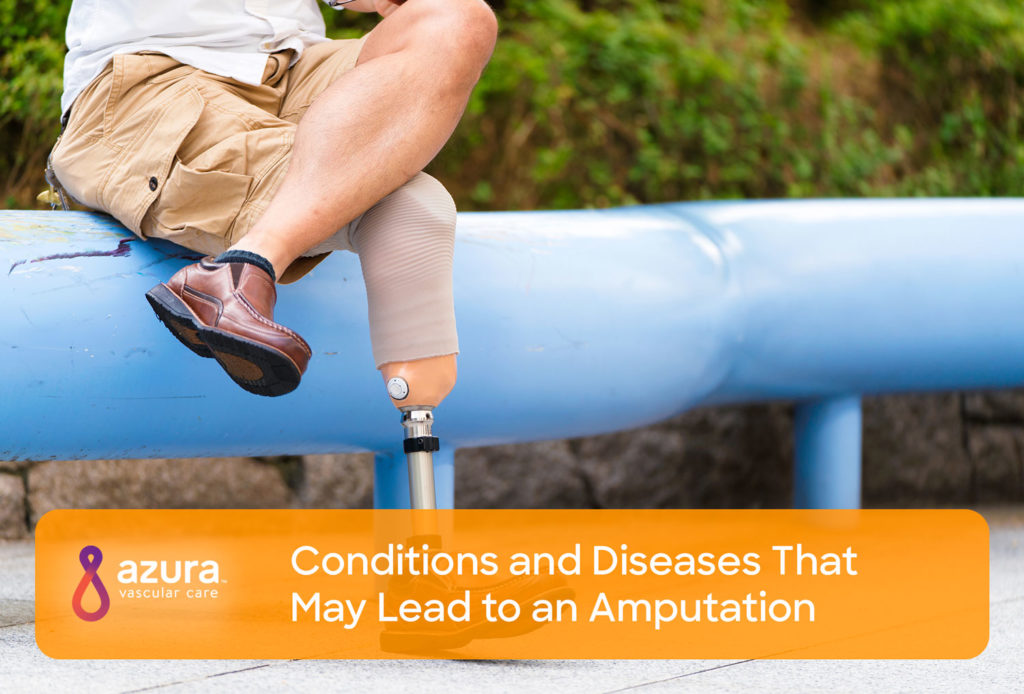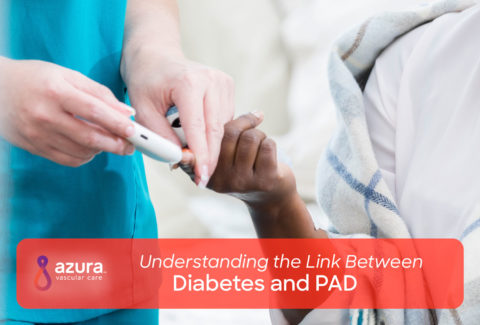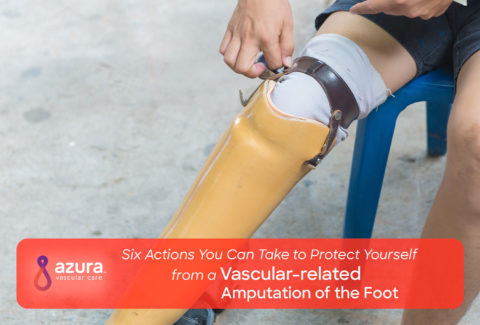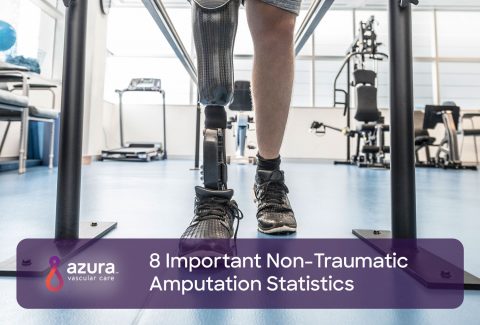
Over half of all amputations are due to vascular conditions, including peripheral artery disease (PAD) and diabetes. (i) These conditions and diseases may impair blood flow in your limbs, which can cause gangrene, non-healing foot ulcers and infected ulcers, and may result in the need for an amputation. (i)
An understanding of the conditions and diseases that may lead to an amputation and the accompanying signs and symptoms will help you recognize your risk and the need to seek care from a vascular specialist. The vascular specialist will discuss interventions and treatments that may help to prevent amputation.
Causes of Amputation
There are two categories of amputation: traumatic and non-traumatic amputation. The main difference between traumatic and non-traumatic amputation is the underlying cause that resulted in the need for an amputation. Traumatic amputations are caused by injuries that destroy blood vessels — usually motor vehicle accidents, gunshot wounds, mechanical equipment and tool accidents. (ii)
The fundamental factor that results in the need for a non-traumatic amputation is impaired blood flow. The need for a non-traumatic amputation occurs most frequently in patients with advanced vascular disease, diabetes, infections, or certain cancers (ii)
How Do You Know if You Are at Risk for Amputation?
Conditions that result from diabetes or untreated PAD, such as a non-healing foot ulcer or an infected foot ulcer significantly increase the risk of needing an amputation. You are at risk for amputation if the affected limb has a deep ulcer or noticeable swelling around the ulcer in the area between your foot and ankle. (iii) Additionally, there may be an increase in an unpleasant smell and discharge from the infected foot ulcer and the presence of a fever. (iii)

You can also recognize the signs and symptoms of diseases that may lead to an amputation based on the general appearance of your hand or leg. An affected limb with a change in skin color to red or black may be gangrene, which may indicate the need for an amputation.
In some cases, the signs and symptoms are subtle. The symptoms may start slowly and insidiously, making it difficult for you to detect the severity of the symptoms.(ii) The presence of other diseases like arthritis, gout, and plantar fasciitis can make it difficult to recognize the signs and symptoms that may lead to amputation. (ii)
If you have neuropathy, you may be unable to feel the pain and may not recognize the severity of your condition. However, you should look out for other signs and symptoms such as coldness of your leg or hand and skin discoloration. (ii) It is important to seek care with a vascular specialist who can determine the severity of the condition and discuss treatment options with you.
People with PAD may experience resting pain because they have impaired blood flow in the affected limb. Untreated PAD increases the risk for amputation, especially when you have ulceration and gangrene in addition to the resting pain. (iv) A foot ulcer with worsening pain, an unpleasant smell, and crumbly tissue that falls apart instead of healing indicates that you have signs of a non-healing diabetic foot ulcer. (v) Serious complications and amputation due to PAD are common if you wait too long for treatment.
Ward Off Amputation
Early recognition and prompt treatment are crucial for preventing amputation related to PAD. (iv) It is critical to see a vascular specialist as soon as you recognize signs of The vascular specialist will discuss treatment options, such as PAD treatment, to restore blood circulation and avert an amputation.
For more information about PAD, download our guide below. Or, to schedule an appointment with a vascular specialist, call 844-LEG-DOCS (534-3627) or request an appointment online.
Sources:
(i) Varma, P., Stineman, M. G., & Dillingham, T. R. (2014). Epidemiology of limb loss. Physical Medicine and Rehabilitation Clinics of North America, 25(1), 1-8. Retrieved from https://www.ncbi.nlm.nih.gov/pmc/articles/PMC4533906/ (accessed 4/5/2018).
(ii) Barraclough, K. (2018). Chronic limb threatening ischemia. British Medical Journal, 360. Retrieved from https://www.bmj.com/content/360/bmj.j5460 (accessed 4/5/2018).
(iii) Pickwell, K., Siersma, V., Kars, M., Apelqvist, J., Bakker, K., Edmonds, M., & Schapen, N. (2015). Predictors of lower-extremity amputation in patients with an infected diabetic foot ulcer. Diabetes Care, 38(5), 852-857.
(iv) Duval, S., Keo, H. H., Oldenberg, N. C., Baumgartner, I., Haff, M. R., Peacock, J. M., & Hirsch, A. T. (2014). The impact of prolonged lower limb ischemia on amputation, mortality, and functional status: The FRIENDS registry. American Heart Journal, 168, 577-587.
(v) Igbal, A., Afroza, J., Wajid, M., & Tariq, S. (2017). Management of chronic non-healing wounds by hirudotherapy. World Journal of Plastic Surgery, 6(1), 9-17. Retrieved from https://www.ncbi.nlm.nih.gov/pmc/articles/PMC5339604/ (accessed 4/5/2018).


